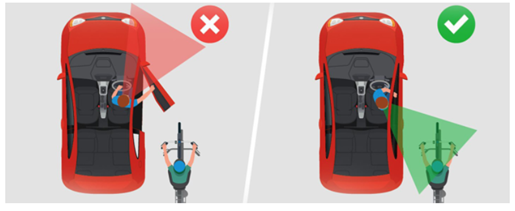It was with pleasure this week that, as part of our induction process for new employees, I was able to introduce them to the great work we do in road safety at Abley, on behalf of our Safe Systems team. The focus for our team is on the Safe System approach to creating a safe transport system; one that recognises humans make mistakes and is designed so that these mistakes do not need to cost lives.
During the discussion, one of our new employees asked what, if anything, we were doing with regard to the Dutch Reach? For those not in the transport space, this doesn’t refer to how generous Dutch people are when at the bar, but rather the practice of a car driver opening their vehicle door with the opposite hand. While at first this may seem odd, it has significant safety benefits for one of the most vulnerable road user groups – cyclists.

Through encouraging (or requiring when mandated) drivers to use their opposite hand to open a vehicle door (see figure 1), they are forced to turn their body and head further when getting out of the car. In effect, this requires four discreet actions that help improve safety:
 Pivoting, the driver will pivot in their seat further than normal increasing their field of view
Pivoting, the driver will pivot in their seat further than normal increasing their field of view- Look back, most, if not all, drivers will already look behind themselves when exiting a vehicle, but the forced movement of using the Dutch Reach, further focuses their attention behind them, further increasing visibility
- Slower opening, because of the cross-body reach, a driver can’t open a door as fast thereby also helping any approaching drivers/cyclists avoid any potential collision
- Exit facing outwards, as the driver’s body has now pivoted further than normal, the driver is more inclined to face outwards when exiting the vehicle rather than inwards, further improving visibility.
The outcome of this process is that with the great improvement in a driver’s line of sight, the blind spot people have when opening a car door with the traditional exit is effectively removed and the roads become safer for all.
The method was adopted into Dutch law back in the 1970’s and has since become engrained in their culture, recognising that these things do take a while to become habit. It was also introduced into the UK Highway code in January, and has been referenced in the South Australian Drivers Handbook. Several other countries refer to this method in their guidance and safety campaigns. Perhaps New Zealand should adopt this method too?
How about giving this a go next time you are getting out of your car…
.png?width=556&height=152&name=Abley_MasterLogo-Website%20(1).png)


